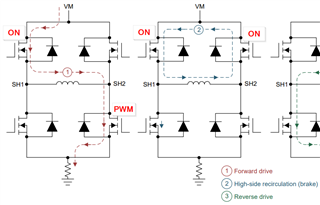Tool/software:
Good day! I am using the DRV8262 on a project, and I need to be able to freewheel both directions when the motor is not running. I have done this in the programming by simply putting the device to sleep (Both Outputs go to High Impedance) when the throttle is in a lower position.
The problem is that any time I engage the throttle while I am pushing the unit with the motor on the wheels, the controller abruptly "grabs" the motor, causing it to come to a complete stop before speeding up to the throttle speed. Is there any way to eliminate or at least dull the latch to zero speed when the motor comes to a halt?




